Last Saturday, with slightly cooler temperatures, I visited Lucca, the charming walled town in western Tuscany. I had forgotten how delightful it is to stroll through Lucca—so compact and beautiful, it is filled with sights to explore and is nearly free of motorized vehicles within the walls.
Partial view of Lucca within the walls.
The main attractions in Lucca are detailed on the Lucca Tourist Information website. Here, I would like to share some highlights from my recent visit.
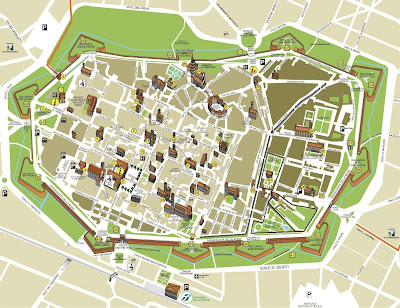
Map of Lucca
I arrived by train from Florence, which takes about 1 hour and 20 minutes. I walked to Lucca’s main entry point, Porta San Pietro, and followed my favorite route through Piazza Napoleone to Piazza San Michele, where I visited the church and admired the exquisite glazed terracotta bas-relief by Luca della Robbia.
The piazza was warm under the sun, but thankfully, Lucca’s narrow streets are mostly shaded. The city is also well-endowed with excellent pasticcerie, which meant I could indulge in pastries accompanied by much-needed cold drinks more than once.
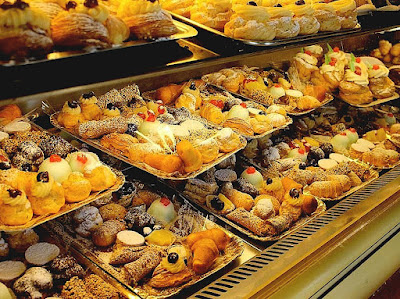
Pasticceria in Lucca
Lucca is surprisingly excellent for shopping, especially considering its small size. Some towns in Tuscany attract affluent visitors from nearby resorts, and thus offer high-quality goods—for example, Pietrasanta, which draws shoppers from Forte dei Marmi. Lucca, on the other hand, caters to a broad audience, with moderate-priced shops selling beautiful ladies’ clothing, along with a variety of leather goods and jewelry shops. The most renowned of these is Gioielleria Carli, a family-owned establishment since the 1600s. I found that Marchi, located on via S. Lucia, offered the best selection of “non-industrial” jewelry, while many other stores featured inexpensive “fashion jewelry.”
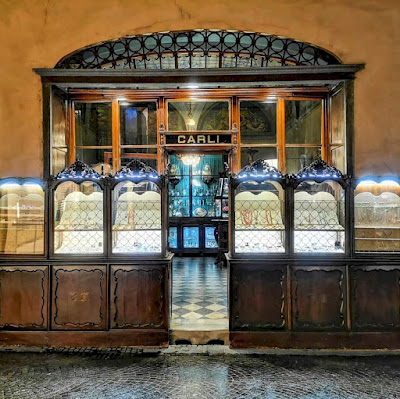
Gioielleria Carli, via S. Lucia, Lucca
Indeed, the small size of Lucca contributes to its shopping allure—numerous streets are packed with intriguing stops, all within easy walking distance. I will skip the salumerie as they are similar to places found throughout Florence and elsewhere. Via Fillungo serves as the main shopping street, featuring a mix of unique stores and several designer outlets offering the same merchandise. However, in the surrounding streets, such as via S. Lucia, you’ll find many independent clothing shops selling lovely linen outfits, as well as various skirts, dresses, and tops.
Next, it was time for lunch. Lucca boasts an impressive selection of quality restaurants. Prices are slightly higher than in other parts of Tuscany, but the quality of the dishes is usually quite good. I returned to my favorite spot—Osteria Rosolo—a favorite among many others as well. Located in the quiet piazza of Corte Campana, off Via Pozzotorelli near the southwest corner of Piazza San Michele, Osteria Rosolo offers traditional Tuscan fare, complemented by lamb chops. I visit for two main reasons: the food is exceptional and the service is incredibly warm, informal, and flexible. They provide an indoor, air-conditioned dining room, but despite the warm temperatures, the outdoor tables were refreshingly cool under the umbrellas. I had a hearty appetite, so I ordered linguine with vongole (clams) which were fresh and delicious, paired with a glass of local white wine. The wine, a trebbiano, is usually quite mild, but in this case was excellent. I also tried the fillet steak on toast with a mustard, cream, and green peppercorn sauce—it was fabulous and cooked to perfection. To accompany that, I enjoyed a glass of cabernet sauvignon from Bolgheri, along with plenty of cold water. They even kindly chilled my red wine for a few minutes, a gesture I truly appreciated given the current heatwave.
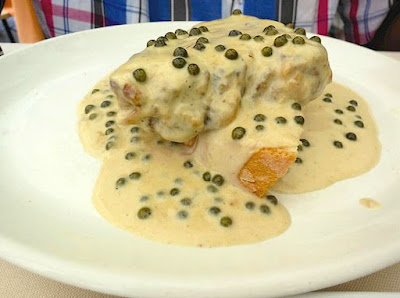
Fillet of beef at Osteria Rosolo in Lucca
In the afternoon, I visited two unique attractions in Lucca: Palazzo Pfanner and the Botanical Gardens.
Palazzo Pfanner, also known as Palazzo Controni, was built in 1660 and is currently home to the Pfanner family. Felix Pfanner (1818-1892), a brewer from Hörbranz near Lake Constance, came to Lucca and established a renowned brewery. He later purchased the Palazzo from the Controni family. His son, Pietro Pfanner (1864-1935), was a surgeon, philanthropist, and mayor of Lucca from 1920 to 1922.
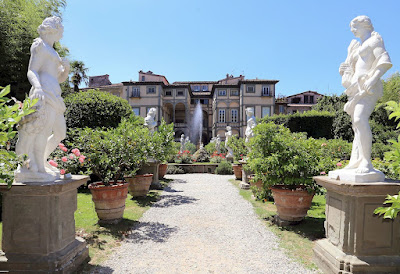
Palazzo Pfanner in Lucca
As my insightful readers will know, I’m an avid garden enthusiast, and I can confidently say that the small garden of Palazzo Pfanner is a true delight, especially on a hot day. I found a peaceful spot in the shade. The garden is surrounded by towering shrubs and bamboo, allowing only the campanile of the Basilica di San Frediano to peek through. In the summer, large terracotta pots with lemon trees decorate the area, while these trees are moved to a special shelter during the winter months. A pathway lined with larger-than-life marble statues leads to a small pond with a simple fountain in its center; the finest view of this pathway is from the stunning loggia of the palazzo. The publicly accessible apartments in the palazzo are moderately interesting and display some historical surgical instruments from Pietro Pfanner. However, the main draw of climbing the grand staircase is the gorgeous view it offers over the garden.
My next and final stop for the day was the Botanical Gardens in the southeast corner of Lucca. You can reach the gardens from Palazzo Pfanner by passing through Piazza del Amfiteatro (which is worth a short visit, as parts of the Roman amphitheater’s stonework are still visible in the walls of the surrounding buildings) and seeing the Torre Guinigi, the famous tower with trees growing on top, before following Via del Fosso alongside its fast-flowing canal.
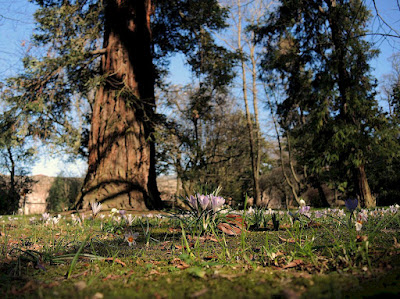
The Botanical Gardens in Lucca – Sequoia sempervirens
Despite being a small town, Lucca boasts an excellent Botanical Garden, featuring an impressive range of specimens, including a giant sequoia and a fine assortment of insectivorous plants. There’s even a grand ginkgo tree, likely one of the first specimens planted in Europe. Ginkgo leaves have been recognized from fossils dating back to the Permian period. This last surviving genus is native to China and was first documented by Engelbert Kaempfer in 1690, after observing a tree in Japan. Specimens quickly made their way into botanical gardens throughout the Western world. Not only are the plants fascinating, but while I was in the gardens, a beautiful hoopoe was busy digging up worms just a few meters away from me. I could easily spend hours in these gardens and will undoubtedly return.
Having spent an afternoon immersed in nature, I couldn’t help but be captivated by the vast tree and shrub nurseries visible from the train on my return to Florence. It reminded me once again of how key horticulture is to Tuscany’s rural economy.
More about Lucca: https://www.lucca.info/
Lucca on Facebook: https://www.facebook.com/lucca.tuscany.italy/
|

Author: Anna Maria Baldini




